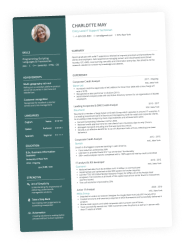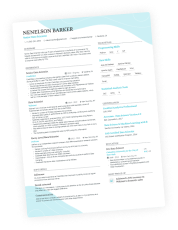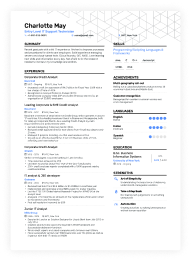Your career is a journey marked by milestones—and promotions are among the most powerful markers along the way. On a resume, they don’t just show job changes—they highlight growth, adaptability, and the value you’ve brought to employers.
But promotions won’t stand out unless you present them effectively. This guide explains how to list promotions clearly and strategically on your resume. It has examples at every step so you can confidently show your upward career trajectory.
Key takeaways
- Always list each promotion with job title and dates (e.g., “Marketing Coordinator, 2018–2020”).
- Use bullet points to show how responsibilities have changed with each role.
- Quantify achievements (e.g., “Increased revenue by 20% after promotion to Sales Manager”).
- Highlight only the most meaningful promotions—skip minor steps if they clutter your resume.
- Keep formatting consistent across all roles.
- Use visual cues like bold titles, timelines, or a “Career Progression” section to highlight growth.
- Avoid vague language—be specific about promotions and outcomes.
- Consider adding promotions to an Awards or Recognition section if they were rapid, competitive, or tied to standout achievements.
Is your resume good enough?
Drop your resume here or choose a file. PDF & DOCX only. Max 2MB file size.
Highlighting career progression: the right approach
Understanding how to document your career advancement can transform a standard progression into a strategic move. When creating your work experience section, show your progression in a way that underscores both your growth and your value to employers.
Start with your most recent role and list earlier positions beneath it. This reverse-chronological format highlights your current expertise while also showing a consistent pattern of advancement. Hiring managers want evidence of ambition and success, and this structure makes it clear.
Instead of writing:
Z-Corp Solutions
Marketing Coordinator, Marketing Manager, Senior Marketing Manager
2016–2022
Write it like this:
Z-Corp Solutions
- Senior Marketing Manager (2020–2022): Led a team of 12, increasing campaign ROI by 35%.
- Marketing Manager (2018–2020): Implemented new CRM tools that reduced churn by 20%.
- Marketing Coordinator (2016–2018): Supported campaign execution and managed vendor relationships.
Action verbs can strengthen your promotion descriptions. Instead of “I was promoted,” write “Advanced from Senior Accountant to Financial Manager.”
Pair this phrasing with the achievements that drove your promotion, such as successfully managing a high-value project or leading a team to measurable results.
Example:
“Advanced from Senior Accountant to Financial Manager after managing a $2M audit project that reduced reporting errors by 40%.”
Finally, tailor your promotion details to the job you’re targeting. Emphasize leadership for managerial roles or technical skills for specialized positions. Coupling your promotions with quantifiable results—budgets managed, revenue generated, teams led—provides proof of your readiness for the next step.
Examples:
“Promoted to Sales Director after expanding regional team from 5 to 18 members, increasing annual revenue by $15M.”
“Promoted to Lead Developer in 2021 after spearheading the launch of a cloud platform now used by 200+ clients.”
Formatting tips for multiple promotions
Presenting multiple promotions effectively requires clarity and consistency. Bullet points are one of the best tools for distinguishing responsibilities and achievements under each role. This structure makes your progression immediately visible to hiring managers.
Example
ABC Tech
Senior Developer | 2021–present
- Directed software migration that saved $500K in licensing fees.
Developer | 2018–2021
- Automated data pipeline, reducing processing time by 40%.
For visual clarity, consider separating promotions with a horizontal line or other dividers.
Always include dates for each role, such as “Manager | 2015–2018” and “Senior Manager | 2018–2021,” so your timeline is easy to follow.
Example:
“Junior Analyst | 2016–2018 → Analyst | 2018–2020 → Senior Analyst | 2020–2023”
This timeline format works well when you want to emphasize quick career growth but don’t need lengthy bullet points for each role.
Keep formatting consistent throughout your resume. Use the same fonts, bullet styles, and resume layout for all roles. A polished and uniform design signals professionalism and attention to detail—both qualities employers look for.
Placing your most recent promotions at the top ensures your most impressive achievements are front and center.
Crafting impactful promotion descriptions
Every promotion tells a story of growth and success. To illustrate this progression, begin by referencing the role you were promoted from, then describe the new position.
For instance, let’s say you have been promoted from Junior Developer to Senior Developer.
Example:
“Promoted from Junior Developer to Senior Developer in 2020 after leading a migration project that reduced downtime by 25%.”
Use action verbs like “led,” “implemented,” and “achieved” to describe what sets you apart.
Quantify results whenever possible: “Oversaw a $500,000 budget, improving department efficiency by 15%.”
Numbers provide credibility and demonstrate the scope of your impact.
Example:
“Implemented a new sales tracking system that increased forecast accuracy by 18%, which led to promotion from Analyst to Senior Analyst.”
Connect promotions to company success by showing how your work contributed to growth. Performance highlights, endorsements, or measurable improvements add credibility and validate your achievements.
Examples:
“Promoted to Team Lead after client satisfaction scores rose 30% due to my process optimization initiative.”
“Recognized by VP of Operations and promoted to Operations Manager after reducing annual costs by $1.2M.”
Visual cues for career advancement
Visual cues help recruiters quickly recognize your career growth. Bullet points, timelines, and bolded job titles all add clarity.
For example, list roles in reverse chronological order to emphasize steady advancement, or create a dedicated “Promotions” section under work experience to highlight milestones.
Example: promotions section
Career Progression at DEF Corp
- Advanced to Senior Manager, 2021
- Elevated to Manager, 2018
Using bold text for each new position draws the eye and reinforces your career progression. Concise achievement summaries after each role, especially with metrics, further illustrate the value you’ve delivered at every stage.
Example
Operations Director | 2022–present
- Increased efficiency by 15% through cross-department strategies.
Operations Manager | 2019–2022
- Expanded team from 8 to 20 members while reducing turnover by 25%.
Highlighting promotions in an awards or recognition section
While promotions usually appear in the Work Experience section, you can also frame them as recognition in an Awards or Achievements section. This works best when the promotion itself was competitive, rapid, or tied to a standout performance.
When to do it:
- You advanced faster than average (e.g., senior role in two years vs. five).
- The promotion was highly selective, almost like winning an award.
- The promotion came with formal recognition (e.g., fast-track leadership program).
Examples
Awards & Recognition
- Recognized with three promotions in six years for consistent revenue growth and leadership excellence.
- Advanced to Senior Manager in record time (2 years vs. company average of 5).
- Selected as one of five employees for leadership fast-track program, leading to promotion to Director.
PRO TIP
Use this strategy as a complement, not a replacement. Your Work Experience section should still show titles, dates, and responsibilities, while the Awards section emphasizes promotions as evidence of recognition and trust.
ATS-friendly promotion formatting tips
Applicant Tracking Systems (ATS) are a reality in many hiring processes, but they aren’t the gatekeepers people often make them out to be. Think of them as filters: they help companies manage applications, but once your resume passes through, a human will be the one making the decision.
That means your resume should be clear enough for software to scan, but compelling enough to impress a recruiter.
Make sure your promotions—and the rest of your resume—get noticed. Try Enhancv’s free ATS-Optimized Resume Scanner!
Here are some best practices to make your promotions ATS-friendly—without sacrificing personality:
- Use standard, readable fonts: All the fonts supported by Enhancv are ATS-compatible. Stick to clean, consistent fonts rather than decorative ones.
- Format dates simply: Use mm/yyyy (e.g., 06/2021–05/2023). While most ATS can parse dates, simple formatting avoids confusion.
- Keep job titles consistent: Place each job title above your responsibilities. Bold is fine, but avoid unusual symbols or spacing.
- Separate or stack entries clearly: Whether you list promotions as separate entries or stack them under one company heading, include both job titles and dates. This shows your work history section clearly.
- Save as PDF (when possible): PDFs preserve formatting and are usually ATS-safe. If an application requires a .docx resume, use that format instead.
- Avoid overly complex design elements: Some ATS struggle with tables, graphics, or text boxes. A clean layout with bullet points ensures your achievements won’t be overlooked.
- Use relevant keywords naturally: Match the job title, formatting, skills, and tools mentioned in the description. For example, write “Google Analytics” if that’s listed, not just “analytics tools.”
Enhancv’s philosophy
Don’t write a resume “for the robot.” Write it for the human—while keeping it clean and structured enough that hiring software can parse it.
Stacked entries at the same company
Google Docs, Inc.
Senior Product Manager | 2021–present
- Launched achievement-based resume feature used by 1M+ users.
Product Manager | 2019–2021
- Directed onboarding steps for new clients, reducing churn by 18%.
Associate Product Manager | 2017–2019
- Supported cross-functional collaboration across marketing and design.
Career progression highlighted in a single block
ABC Corp, New York, NY
2016–2022
- Promoted from Sales Representative → Sales Manager → Regional Sales Director.
- As Director, managed a $10M portfolio and 20 sales professionals.
Template for users
[Company Name]
[Most Recent Job Title] | (mm/yyyy–present)
- [Key achievement/responsibility tied to promotion].
[Previous Job Title] | (mm/yyyy–mm/yyyy)
- [Key achievement/responsibility].
This structure can be built easily with ATS-friendly resume templates in tools like Google Docs or Enhancv.
Listing lateral moves and title changes
Not all role changes are promotions. Sometimes you move laterally, switch departments, or get a new job title after a company restructuring. These still matter and should be listed clearly.
Lateral move between departments
XYZ Global
Marketing Analyst | 2019–2021
- Conducted market research and developed reports.
Business Analyst | 2021–2023
- Transitioned to the Finance department—created models that improved forecasting accuracy by 22%.
Job title change with overlapping responsibilities
TechStart Inc.
Support Specialist | 2018–2019
- Managed onboarding steps for new clients.
Customer Success Associate | 2019–2020
- Continued onboarding duties but expanded role to include retention strategies.
When listing lateral moves:
- Use reverse chronological order.
- Keep bullet points focused on new accomplishments and duties.
- If titles change without new responsibilities, clarify with a short note: “(Title change due to company restructuring).”
Common mistakes to avoid when listing promotions
Avoid vague descriptions like “moved up in the company.” Instead, clearly state each promotion with the new job title, date, and key responsibilities.
Example:
❌ “Moved up in the company.”
✅ “Advanced to Senior Analyst in 2021, overseeing a team of five on key client projects.”
Be consistent with formatting across all roles. Inconsistencies distract from your achievements and can appear unprofessional. Similarly, don’t bury promotions in text blocks—make them visible with bullet points or bold headings.
Finally, keep language simple and direct. Instead of corporate jargon, use straightforward phrasing that makes your growth clear: “Promoted to Chief Operations Officer in 2022, leading cross-functional teams and managing strategic projects.”
Example:
❌“Elevated to a C-Level position with oversight of multi-faceted strategic initiatives.”
✅ “Promoted to Chief Operating Officer in 2022, responsible for leading company-wide strategy and 200+ employees.”
Frequently asked questions and common challenges
Q. Should I list every role if I’ve had multiple at the same company?
A. Not always. If roles were short-term or similar in scope, combine them. But if they show significant career progression or new responsibilities, separate them.
Q. How do I list promotions without looking like a job hopper?
A. By showing them under one company heading. Dates of employment stay continuous (e.g., 2015–2023), while job titles underneath reflect your growth. This proves stability rather than inconsistency.
Q. Should I include promotions in my resume summary?
A. Yes. A resume summary (or resume objective) can highlight progress: “Advanced three times in six years for consistent revenue growth and leadership excellence.”
Optimize your resume summary and objective for ATS
Drop your resume here or choose a file.
PDF & DOCX only. Max 2MB file size.
Q. What if I’m asked to prove my promotions during the interview process?
A. Bring evidence: performance reviews, promotion request letters, references, or metrics tied to your advancement. Proof shows your growth is validated.
Q. How do I handle multiple roles with overlapping responsibilities?
A. Clarify with bullet points that emphasize differences. Even if duties overlap, highlight new scope, leadership, or achievements gained.
Too many resumes hide career growth under one generic job entry, and that’s a wasted opportunity. Every promotion is proof that you earned trust, delivered results, and outpaced your peers. Show it off like a badge of honor, because that’s exactly how hiring managers see it.
Writer’s take
Conclusion
Promotions are more than just job title changes—they’re milestones that prove your growth, adaptability, and ability to deliver results. By breaking out each promotion with job titles, dates, achievements, and visual cues, you create a resume that tells a clear story of career advancement.
Remember: every promotion should have its own “before and after” story. Highlight new skills, expanded responsibilities, and measurable wins that demonstrate why you were trusted to take the next step.
To make this process easier, try Enhancv’s free AI Resume Builder. It helps you format your career progression professionally, ensures consistency, and makes sure your promotions shine in a way that catches hiring managers’ eyes.
Make one that's truly you.



